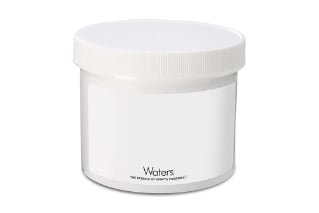
|
Separation Mode |
Reversed Phase |
|
Detection Method |
UV |
|
Formulation |
Liquid |
|
Storage Condition |
Room Temperature |
|
System Type |
LC |
|
Shipping Condition |
Ambient |
|
Volume |
50 mL |
|
Type |
Reagent |
|
UNSPSC |
41116105 |
|
Product Type |
Reagents |
|
Units per Package |
5 pk |
PIC Reagent D4
One of the methods for performing ion-exchange separations on a reversed-phase column is Paired-Ion Chromatography (PIC). This is achieved by adding Hydrophobic paired-ion reagents to the mobile phase, which adsorb onto the stationary phase and enhance the interactions of oppositely charged sample components. A paired-ion reagent increases the retention of oppositely charged solutes, decreases the retention of equally charged solutes, and does not impact the retention of uncharged solutes-- thereby allowing scientists to review data in much more depth. The PIC reagents assist in providing an easy solution for analyzing samples containing ionic species. The reagents enable the ionic compounds to be separated by reverse-phase chromatography, which leads to saving time by allowing simultaneous assays of acids, bases, amphoteric and neutral compounds.
PIC Reagent D4 is Dibutylammonium phosphate, and Water provides it in a 5 vial/pkg in a workable UV range in mobile phase 215+ nm. Similar to all the reagents offered by Waters, the PIC Reagent D4 has been produced in a very strict quality control environment to guarantee consistent results and batch over batch reproducibility. The reagent has been preformulated for ease of use and has also been buffered to an appropriate pH for most acidic and basic compounds.
All Waters PIC reagents are premixed and buffered. You can add 1 vial of reagent to 1 L of mobile and filter as needed. Unopened PIC Regents can be stored at room temperature and pressure for up to one year of shelf life, and mobile phase containing the reagent can be stored indefinitely without loss of effectiveness. Kindly note, crystals may form when vials are exposed to lower temperatures; in such instances, we advise to gently warm the vial until the crystals go back into the solution.
You can effectively use the PIC Reagent D4 as a mobile phase modifier when separating basic pharmaceutical compounds to improve peak shape and reduce retention times. To learn more about the variety of other reagents available by Waters, such as the PIC Reagent D4 listed here, or to find different products that work with it or even to shop for lab equipment so you can replenish your stock and add to your existing equipment portfolio, you can browse our website and refer to our catalog.
You might also be interested in PIC Reagent A, which is a Low UV is a 5 vial/pkg of tetrabutylammonium phosphate in a workable UV range in mobile phase 240+ nm.
What Are Neutral Compounds?
Neutral compounds in your samples and analysis may include hydrocarbons (alkanes, alkenes, alkynes, aromatic compounds), alcohols, aldehydes, ketones, esters, amides, nitro compounds, etc.